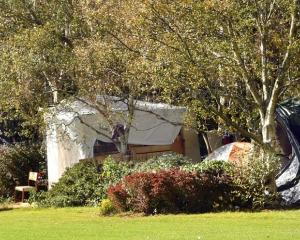
The outcome is not certain, but collecting the gas for use as energy, an issue that has caused the Dunedin City Council a long-running headache, may be a step closer thanks to new technology.
Council solid waste manager Ian Featherston said yesterday residents near the landfill would soon notice a large, blue-coloured flame at night as the council began burning off the methane it is collecting at the site in a $2.5 million project.
"This temporary back-up flare is being used to test the quantity and quality of landfill gas available from the landfill, and it is expected to be in place until October this year, at which stage a new permanent flare will be installed."
But Mr Featherston said having the permanent flare in place did not preclude the energy being harnessed in future if an economic system was found.
The attempt to collect and harness the gas at the site has a long history.
In 1995, the council spent $3 million installing a collection system, with hopes the gas could be cleaned and piped into the national grid to be used as fuel.
But the landfill was too big and shallow to extract the gas efficiently; the gas accumulated unevenly; and some of the extraction pipes failed.
Citigas sued consulting firm Montgomery Watson for $1.2 million, citing poor advice over the project, and eventually received a $540,000 out-of-court settlement.
In 2005, the Government introduced a law requiring gas-recovery systems to be installed in all large landfills by 2007 to stop methane escaping and damaging the ozone layer.
In 2007, the cost of using it for fuel or to generate electricity was estimated at $8.7 million, but the council rejected the plan as too expensive, instead optingfor a cheaper flaring-off option.
Burning the gas was important because it was a greenhouse gas that remained in the atmosphere for between nine and 13 years, and was 20 times more effective at trapping heat in the atmosphere than carbon dioxide, Mr Featherston said.
Burning produced carbon dioxide, but that was 20 times less harmful.
The amount of gas, and the length of time it would be produced, depended on the construction of the landfill and the materials used, he said.
It could last as long as 20 years, but the quality and quantity of gas would not be known until testing was complete.
There was a five-stage process of setting up the system, requiring building a pile, putting fill material around it, capping it to trap the methane and putting in gas bores. Work was still at the first stage.
There were four bores at present, but the number would be progressively increased to 54.
Using the methane could provide significant energy, economic and environmental benefits, but while "it is one thing capturing the landfill gas, it is another to do something beneficial with it", he said, referring to the cost of harnessing it.
In Auckland, methane from landfills was used for generating electricity, and Christchurch used its gas for heating the QEII Park swimming pool.
Infrastructure services committee chairman Cr Andrew Noone said technology had advanced to the point where possibilities existed for economically harnessing the gas.
Mr Featherston said he would be discussing the matter with the council's energy manager, Neville Auton, and he hoped a report laying out the options, following the testing, would be presented to the council later this year.
Advertisement












